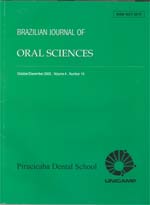
|
Brazilian Journal of Oral Sciences
Piracicaba Dental School - UNICAMP
EISSN:
Vol. 13, No. 3, 2014, pp. 209-212
|
 Bioline Code: os14039
Bioline Code: os14039
Full paper language: English
Document type: Research Article
Document available free of charge
|
|
|
Brazilian Journal of Oral Sciences, Vol. 13, No. 3, 2014, pp. 209-212
| en |
Body mass index, dental caries and sugar intake in 2-5 year-old preschoolers
Martins, Ronald Jefferson; Moimaz, Suzely Adas Saliba; Silva, Mirelli Ramiro; Saliba, Orlando & Garbin, Clea Adas Saliba
Abstract
Aim: To determine the association between dental caries, Body Mass Index (BMI) and sugar intake in children attending primary school. Methods: A cross-sectional study was conducted with 91 children, with mean age of 3.9 years (sd = ±1.0), considering anthropometric measurements, according to standardized methodology of the Ministry of Health and occurrence of dental caries was recorded from clinical examinations (dmft). The sugar intake level was measured with a questionnaire that was applied to parents/caretakers of the children. The association of the variables was checked using a correlation with the Contingency C coefficient test. Results: 33 (36.3%) children were at risk for overweight, overweight or obese. Of these, 10 (30.3%) had dmft ≥ 1. An association was found between sugar added to the bottle and child dmft (coeff. C = 0.5853 and p <0.0001) and also with BMI (coeff. C = 0.5693 and p <0.0001). There was no association between BMI and caries (chi-square = 0.1447 and p-value = 0.7036). Conclusions: It was concluded that there was a correlation between sugar intake and dmft and BMI, but not between caries and BMI.
Keywords
child, preschool; body mass index; dental caries; obesity
|
| |
© Copyright 2014 - Brazilian Journal of Oral Sciences
Alternative site location: http://www.fop.unicamp.br/brjorals
|
|
